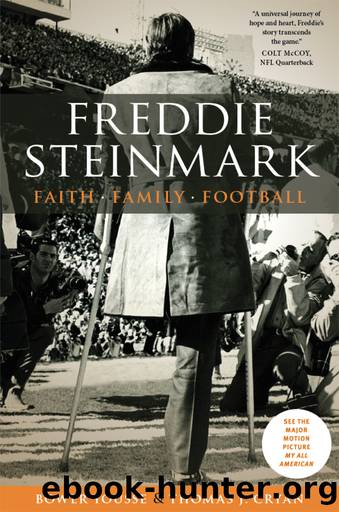Freddie Steinmark by Thomas J. Yousse

Author:Thomas J. Yousse [Yousse, Bower]
Language: eng
Format: epub
Publisher: University of Texas Press
Published: 2015-01-15T00:00:00+00:00
CHAPTER 11
THE GAME OF THE CENTURY
FREDDIE STOOD IN THE BACK OF THE HUDDLE, shaking out his leg and tapping his left toe against the turf. The previous play had been damaging for the Longhorns. On third down, Chuck Dicus had run a twenty-yard crossing pattern, twisted at exactly the right moment, and caught the pass from Arkansas quarterback Bill Montgomery. Freddieâs ailing leg wouldnât cooperate, and he arrived lateâmuch too late.
The sea of Razorback red roared. The stadium shook. Cowbells clanged. The university marching bands, each perched behind their teamâs bench, worked to overcome the other. They bobbed to the rhythms, jabbed their instruments into the air, and shot out close-fire notes. The low ceiling of grey clouds amplified every cymbal crash, every rat-a-tat drumbeat, every lung-bursting note, every shout in the stands, every grunt on the field.
Texas linebacker Scott Henderson, breathing heavily, looked to the sideline for Coach Campbellâs signal. Henderson would later remember Campbell as a defensive âgenius,â a man often capable of predicting the offenseâs next play. With the flashed signs, Henderson pivoted to the huddle and leaned in. â80 regular!â he screamed. â80 regular! Readyâbreak!â The Longhorn defense clapped in unison and spread out.
Arkansas, leading 14â8, had a first down on the Texas thirty-eight-yard line. If the Razorbacks scored, the game would probably be out of reach.
Freddie cheated backward a few steps to compensate for the lack of mobility caused by his painful leg. He nodded to Danny Lester on his right and then to Tom Campbell on his left. They silently acknowledged the coverage schemeâeach was responsible for a deep third of the field. Though this âcover 3â spread zone had proved stout all season, it seemed vulnerable to the Arkansas offense. So far, Montgomery had completed twelve passes, seven of them to Dicus.
The scoreboard clock showed 12:27 left in the game. If Texas could stop Arkansas now, there was enough time for the Longhorns to score again. Freddie crouched with his weight on his toes, catlike, ready to pounce. Dicus set slot right, and flanker John Rees split to the left. Freddie knew they were coming his way. He splayed his fingers and fixed his eyes on Dicus.
AIR FORCE ONE HAD TOUCHED DOWN EARLIER IN THE day at Fort Smith, sixty miles south of Fayetteville. The game, referred to by the media as the âBig ShootoutââCoach Royalâs descriptionâwas set to begin at high noon in the style of a Gary Cooperâlike showdown.
President Richard Nixon, a well-studied college football fan, appeared uncharacteristically excited as he stepped from his plane and addressed the crowd gathered on the tarmac: âAll that I know is that weâre going to see, today, in this hundredth anniversary of football, one of the great football games of all time.â Marine One lifted off for Fayetteville shortly after eleven thirty. Among those accompanying Nixon were Congressmen George H. W. Bush of Texas and John Paul Hammerschmidt of Arkansas. Four Chinook helicopters, one of them carrying members of the press, embarked for the stadium.
Download
This site does not store any files on its server. We only index and link to content provided by other sites. Please contact the content providers to delete copyright contents if any and email us, we'll remove relevant links or contents immediately.
| Baseball | Basketball |
| Boxing, Wrestling & MMA | Football |
| Golf | Hockey |
| Soccer |
Imperfect by Sanjay Manjrekar(5750)
Wiseguy by Nicholas Pileggi(5618)
The Body: A Guide for Occupants by Bill Bryson(4893)
Tuesdays with Morrie by Mitch Albom(4608)
Unstoppable by Maria Sharapova(3441)
Not a Diet Book by James Smith(3302)
Crazy Is My Superpower by A.J. Mendez Brooks(3277)
Into Thin Air by Jon Krakauer(3268)
The Mamba Mentality by Kobe Bryant(3155)
The Fight by Norman Mailer(2808)
Finding Gobi by Dion Leonard(2726)
Tuesdays With Morrie by Mitch Albom(2636)
The Ogre by Doug Scott(2606)
My Turn by Johan Cruyff(2532)
Unstoppable: My Life So Far by Maria Sharapova(2423)
Accepted by Pat Patterson(2272)
Everest the Cruel Way by Joe Tasker(2214)
Open Book by Jessica Simpson(2185)
Borders by unknow(2152)
